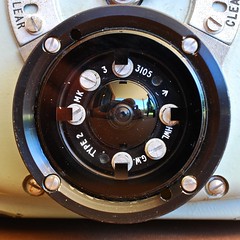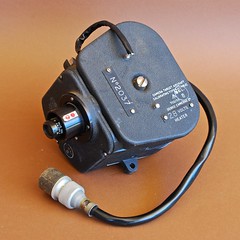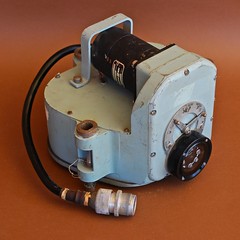User:Heritagefutures/WorkSpace3
Contents
Missile Stuff
Missile Cameras
Cameras played a major role in documenting the experiments and testing carried out the early days of guided weapons development. A suite of specialised cameras were developed in the mid- to late 1950s by various U.S. manufacturers, by Soviet camera makers and by the Royal Aircraft Establishment in the UK.
In Australia, the Weapons Research Establishment (South Australia) designed such cameras as part of the Anglo-Australian Joint Project (1946 to 1980) which focussed on guided weapons and missile development. The research focussed on a missile's behaviour in flight relying on observation and general telemetry data. While the latter would be displayed on an cathode-ray oscilloscope in real time, they needed recording to allow for detailed analysis. Film was a suitable medium to record such transitory analog data. To this end, high-speed cine cameras were developed which capable of 100 frames/second and more. While recorded data would be viewed as segments of motion film many were analysed on a frame-by-frame basis.
In principle, cameras were developed for four different applications: ground-based cameras for observation and the recording of the telemetry, and airborne cameras, either borne by the missile or carried by the target.
Ground based cameras
Missile behaviour
- Telemetry recording
Recording of moving Oscillograph data occurred principally with the GW 3 camera. Such cameras also existed in the civilian arena (such as the Cossor 1428).[1]
Airborne cameras
Missile-borne cameras
Target Aircraft Cameras
Notes
- ↑ The Fairchild F-296 is an example of camera used to record stable oscillograph data where a single image sufficed for the purposes documentation.
| FEEL FREE TO LOOK, BUT PLEASE DO NOT TOUCH... |
Beck
- Asymmetrical Lens clean mine!
Beck Sky Camera
British pat n°225 398/1923
Focal length near 1 inch (2.5cm) and image circle is approximately 3 inch (7.5cm) For circular images 2½ in. dia. on 3¼ x 4¼ in.plates, English, c. 1924, the mahogany box-form body with fixed focus brassbound R&J Beck 180 'fish-eye' ƒ8 lens with three built-in filters, and one block-form double plate holder. Designed and patented by Robin Hill of the Biochemical Laboratory, Cambridge in 1923, British Pat. No.31931/23, for photographing cloud formations. The distortion produced by the lens was corrected by using the same lens again for projection of the image. It was used by the Meteorological Office for many years. Original price £18/18/0. Literature: R. Hill, Quarterly Journal of the Royal Meteorological Society. Vol.50 (1924) p.227-23; Dr.H.v. Socher, Optik Mit 180 Gesichtsfeld, Das Deutsche Lichtbild, 1931.
Camera has built-in shutter. Speeds are: 1/100, 1/50, 1/25, 1/10, 1/5, 1/2, 1sec, B and T. Lens has built-in yellow filter. Apertures are 8, 11, 16, 22 and 32
Beck Guided Weapons Lenses

|
| R&J Beck designed G.W. Type 2 Mk.3 lens image by Dirk HR Spennemann (Image rights) |
The folowing lenses have been documented
- GW Type 2 Mk 2 (on a Dekko GW 1 Mk1A)
- The lens is
- GW Type 2 Mk 3 (on a Dekko GW 1 Mk1A and a Beck GW 2)
- The lens is similar to the Type 2 M2, but is surrounded by four diodes for @@@
- GW Type 3 Mk 2 (on a Dekko GW 1 Mk1C)
| FEEL FREE TO LOOK, BUT PLEASE DO NOT TOUCH... |
| Military Cameras |
|---|
| Aerial Cameras | XXX | Fairchild F8 | Fairchild K-17 | XXX | XXX | XXX | XXX | Solar-Vought Torpedo Camera | |
| | Konishiroku GSK-99 | | XXX | XXX | XXX | XXX | XXX | XXX | |
| Combat Cameras | XXX | XXX | Simmon PH-501/PF | XXX | XXX | XXX | XXX | XXX | |
| Gun Cameras | XXX | XXX | XXX | XXX | XXX | XXX | XXX | XXX | |
| Missile Cameras | WRECISS | WREROC | WRETAR | XXX | XXX | XXX | XXX | XXX | |
| FEEL FREE TO LOOK, BUT PLEASE DO NOT TOUCH... |
| FEEL FREE TO LOOK, BUT PLEASE DO NOT TOUCH... |
Dekko GW 1
| Heritagefutures/WorkSpace3 |
|---|
|
Manufacturer: Dekko Cameras Ltd
Film type: 35mm
|
Background
While technically a high speed cine camera, shooting at 100 frames/second, the resulting negatives were not projected as a film but examined individually in order to assess the miss distance of the missile in relation to its target. The film magazine took a standard 50ft roll of 35mm cine film, which gave the camera a run time of 12 seconds.

|
| Dekko GW 1 Mk 1A image by Dirk HR Spennemann (Image rights) |
Technical designs
Mk 1A
Mk 1B
The existence of a Mark 1B camera can be inferred but units of this type have not been available for examination at the time of writing.
Mk 1C
Mk 1D
The identification data engraved on the cover for the film magazine-loading bay read the same as those documented for the Mark 1C, with the exception that the text Mk 1C’ has been replaced by ‘Mk 1D.’ The sole Mk 1D unit examined carried a R&J Beck GW Type 3 lens. There is no readily visible difference between the Mk1C and Mk1D models, either in overall appearance, lenses or mechanics.
Links
- ¶¶ Spennemann, Dirk HR (2012) History, Description and Technical Details of the GW Target Aircraft Cameras. vers. 1.0 {: CAMERA | TOPIA :}
Notes
| FEEL FREE TO LOOK, BUT PLEASE DO NOT TOUCH... |
Beck GW 2
| Heritagefutures/WorkSpace3 |
|---|
|
Manufacturer: Dekko Cameras Ltd
Film type: 35mm
|
Background
While technically a high speed cine camera, shooting at 100 frames/second, the resulting negatives were not projected as a film but examined individually in order to assess the miss distance of the missile in relation to its target. The film magazine took a 100 foot roll, which gave the camera a run time of 12 seconds.
Technical designs
Links
- ¶¶ Spennemann, Dirk HR (2012) History, Description and Technical Details of the GW Target Aircraft Cameras. vers. 1.0 {: CAMERA | TOPIA :}
Notes

